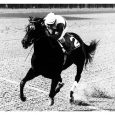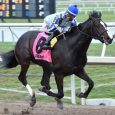
Frosted
There is an old saying that goes: “You can lead a horse to water, but you can’t make it drink.”
It is very true in our great game of skill — the greatest skill gambling game in the world, in my humble opinion. People form habits, nuances, superstitions and, of course, opinions and they are very reluctant to change them.
What makes it more interesting is that so much of our game is opinion-based and subjective. There are, however, many aspects of the Sport of Kings labeled opinion or subjective that, in fact, aren’t. Knowing when such is the case is a key element of getting into the small, exclusive and elusive club of people who actually beat the game. That is maybe 5-10 percent of regular players, which tells you how difficult it is, how much work it takes and how much talent one needs. There are other elements required to get into this club, but that is a topic for another day.
I’d be remiss if I failed to point out the subject we are getting to is not a subject I haven’t discussed before. Like that old saying notes, though, it is hard to change the mindset of a horse player or handicapper.
After Frosted won the Whitney in seemingly impressive fashion, I heard two well-known TV analysts say “good horses don’t bounce.” Based on a conversation I had one day at Saratoga with the late and very great Bobby Frankel, I can say unequivocally he would disagree. I read similar words from some pretty well-known turf writers. A gambling man by nature myself, I’d bet none of them are in the elusive club we mentioned earlier. I’d lay nice odds on it too!
First of all, to make any statement about a bounce, or even to have any opinion on whether horses bounce you have to actually know what a bounce is. I hear players say, “I hate that term, it is nonsense, there is no such thing.” Yet, the vast majority of them do not know what the term actually means and refers to. They think they do, thus the opinion, but they don’t — and this is not subjective.
If you are not a “Sheets” player, meaning Ragozin or Thoro-Graph, then you likely don’t know what a bounce is or how to recognize one. I have used both products extensively for many years. Today, I am a Thoro-Graph user, so much so that I can usually tell you the number or figure a horse will receive before it is assigned. More often than not, I’m spot on. If you understand the term “bounce” refers to the Thoro-Graph sheets, or “The Rags” and you do not use them or are not familiar with how to read them, you should be ready to admit you don’t truly grasp the concept.
Let’s clear up some basics: Thoro-Graph is about patterns and form cycles. You have to know how to read them and they are best used as a tool to compliment your past performances and give you an edge. An edge is very important in a game where you are playing against the other players in the pool and not the house. You will never get an edge on the house. The other players in the pool? Well, that’s a piece of cake.
Beyer figures, Brisnet figures and Timeform figures — all raw speed figures that do not allow for trip, distance traveled, wind and other factors — will not identify or reflect a bounce. I am not knocking any of them, I’m just pointing out something they do not do.

A bounce is a significant regression in a horse’s figure on Thro-Graph after a new top figure or a return to a previously higher figure than they normally run. For example, if a horse runs five races and his figures are 3, 3, 4, 2, 2 and then he runs a 4, it is not a bounce. He regressed some, but he didn’t bounce.
If, on the other hand, the numbers are 4, 5, 5, 4, 1 and then he runs a 6, he bounced. The forward move and the regression have to be significant. Going a step further, if a 6 can win the race, then, yes, a horse can bounce and win in that scenario. Knowing in advance if and when a horse will bounce takes a little more than that, but you should at least now know what a bounce is.
Frosted rode a strong closers bias to victory in The Metropolitan Mile on Belmont Stakes Day. He ran the fastest race ever to date on Thro-Graph, an 8-. Prior to that, the fastest I recall was Dreaming of Julia in the Gulfstream Park Oaks, in which she recorded a 6-. Both tremendously fast races… and races that almost always take their toll.
Dreaming of Julia bounced off the race and didn’t hit the board in the Kentucky Oaks, won by stable mate Princess of Sylmar. Beholder was second. Dreaming of Julia was off bad, but that wasn’t what got her beat. It may have been contributory, but she bounced and showed significant regression off the huge Gulfstream win. She was the favorite and I did not have her on a single ticket, tweeting out in the morning that Princess of Sylmar had a huge shot.
Knowing when horses will regress is truly an edge.
Frosted won off his monstrous Met Mile, albeit in the bias-aided Whitney. He was coming off that huge 8-. He had to bounce. The problem was the competition was a cut below, he got an easy lead, jockey Joel Rosario got him to relax in front and he cruised to victory. That’s when the “good horses don’t bounce” comments rolled off the tongues of the analysts and flowed from the keyboards of writers.
Why argue, he won?
I simply smiled. I knew Frosted bounced and had won anyway. He wouldn’t lose again all year, some said, and a Breeders’ Cup Classic showdown between him and California Chrome was anticipated. People forget there can always be an Arrogate lying in wait somewhere and the Breeders’ Cup Classic is in the fall, not the summer. In a game where things can drastically change in a second, I never understood an advance bet at less than 75-1 on anything, or how anyone who knows the game can have an opinion on the outcome of a race not even drawn yet. Not only did I think he’d lose this year, I wondered if he’d win another race.
Frosted won the Whitney, as he did The Metropolitan Mile, under optimum conditions. He ran an 8- in The Met and regressed, or bounced, to a 3- in The Whitney. That is a 5-point regression. That’s significant and indicative of a horse going in the wrong direction from a wagering standpoint. This is to take nothing away from Frosted or any of his accomplishments, nor is it a knock on him as a racehorse or a knock against his connections. It is my analysis of his form and form cycle from a wagering standpoint. It is not a fan perspective, so Frosted fans please understand this.
When Frosted ran back in the Woodward off an 8- to a 3- pattern he was ripe to be upset and I bet against him at 1-9 with both hands. He was almost sure to regress again. He was running back quick off two big races and on a downward form cycle. This is not a win recipe. Even if he regressed 3 points to a 0 or 4 points to a 1, that would make him simply a contender. It would not make him a bounce-and-win candidate.
Frosted didn’t get the lead in The Woodward and sat off the pace, under a very confident ride by Rosario. He ran a big race and he is a really good horse, but the last eighth when he really needed that kick, it wasn’t there. It was back in The Met and Whitney. He was lugging in late and looked tired, especially when he galloped back.
Some people criticized Rosario for not going to the whip. I disagree. First of all, Frosted does not like the whip and was already all-in. Second, Rosario could not go to the left hand, as his horse was all over the horse inside him. A horse can and will lug in when tired. Third, if he hits him right handed, they might have finished the race on the grass course.
At this point, it is more likely Frosted is in the Breeders’ Cup Mile as opposed to the Classic. That is a tricky race at Santa Anita where they start right on the turn and outside draws are at a disadvantage. He may go in the Classic, but taking on California Chrome, who may train to the Classic, and Arrogate, who may also train to the Classic, off a race like his Woodward may not be ideal.
Do you think both Bob Baffert and Art Sherman are considering training up to the Classic off both their runners’ monster races in the Pacific Classic and Travers respectively has anything to do with avoiding the bounce?
Nah, good horses don’t bounce, remember?




